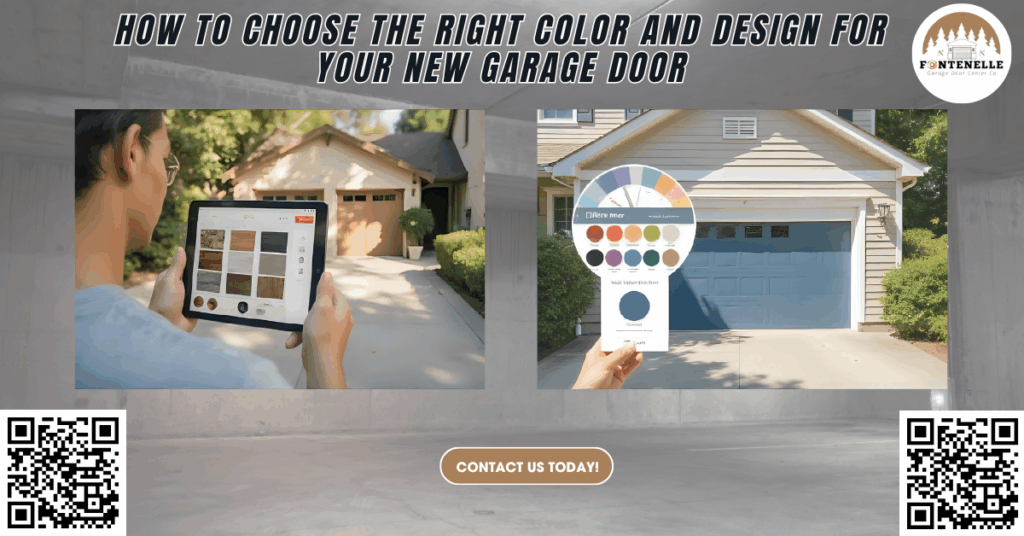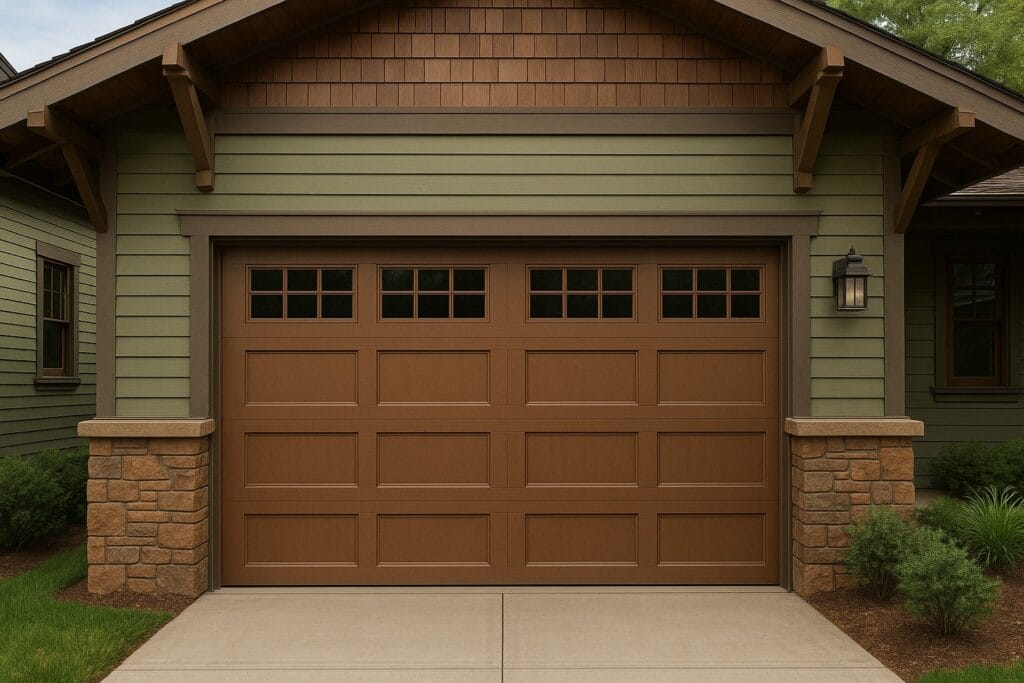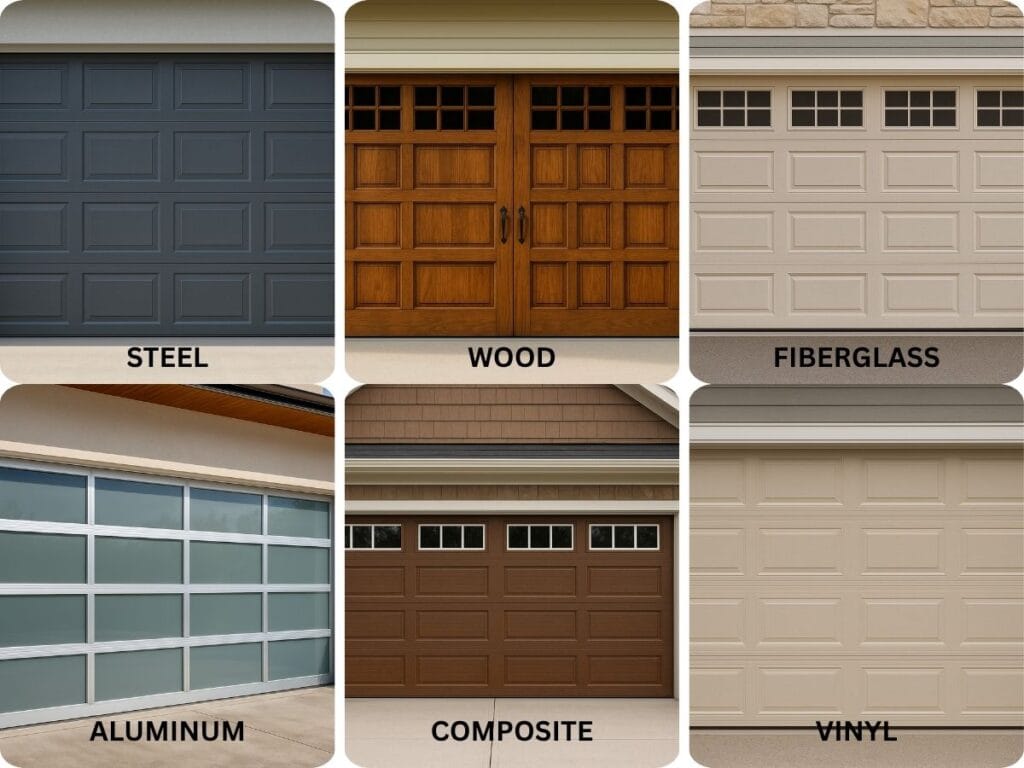How to Choose the Right Color and Design for Your New Garage Door

When David O’Mara, a Bellevue homeowner, decided it was time for a garage door replacement, he didn’t expect such a significant transformation. His 20-year-old wood garage door was warped, the insulation was poor, and his outdated garage door opener was noisy and unreliable. After working with our team at Fontenelle Garage Door Center Co., David upgraded to a custom steel garage door with smart opener technology. The result? Improved curb appeal, quieter operation, better energy efficiency, and even a bump in home value—all accomplished in under two weeks.
Garage doors are a vital part of every home. They are not only functional but also highly visible, making them one of the most prominent features on your property. Remodeling Magazine’s Cost vs. Value Report consistently ranks garage door replacement as one of the top ROI-generating home improvements, offering a return of over 102.7% in many markets, including Nebraska. For homeowners seeking to enhance aesthetics and functionality, choosing the right new garage door design and color is a decision that pays off in the long term.
This comprehensive guide is designed to walk you through every aspect of selecting the perfect garage door for your home. We’ll explore garage door styles, materials, colors, features, and even the impact of insulation, safety, and smart technology. Whether you’re a first-time buyer or planning your third garage door replacement, this guide will help you make informed choices tailored to your home’s needs and your taste.
Why Your Garage Door Design Matters
A garage door often makes up 30–40% of a home’s visible exterior. As such, its design has a profound impact on your home’s curb appeal and resale value. Beyond appearance, the door’s structure, materials, and technology also influence safety, energy efficiency, and long-term maintenance costs.
A well-chosen garage door enhances architectural harmony. For instance, a craftsman-style home looks far more cohesive with a craftsman garage door featuring carriage house panels, decorative hardware, and earthy colors. In contrast, a modern-style house may benefit from sleek, flush panels and bold hues like black or anodized aluminum. Poor design choices, on the other hand, can diminish the appearance of your home, clash with exterior finishes, or even devalue the property.
Additionally, modern garage doors are more than simple access points. They offer advanced safety features, smart home integration, and high R-value insulation for improved comfort during Nebraska’s cold winters. Choosing the right door ensures that you don’t just improve looks, but also enhance security, reduce energy costs, and increase the door’s durability for years to come.
Step 1: Know Your Home’s Architectural Style
The first step in selecting your new garage door is understanding your home’s architectural identity. This ensures visual consistency and enhances the overall character of your house.
- Traditional Homes often pair well with raised-panel garage doors in soft, neutral tones like white, almond, or sandstone. Adding windows with colonial grilles or sunburst patterns reinforces the classic look. Steel doors are especially popular here due to their durability and timeless appearance.
- Modern or Contemporary Homes shine with flush panels, minimalistic lines, and bold color options like black, charcoal, or silver. Aluminum and glass sectional garage doors are perfect for this style, adding transparency and a clean aesthetic. Pair these with a belt drive smart garage door opener for silent, smooth operation.
- Craftsman-Style Homes, popular throughout Bellevue neighborhoods, look best with carriage-style garage doors featuring wood or wood-look composite materials. These styles include details like X-braces, decorative hinges, and window inserts that echo the handcrafted nature of craftsman architecture.
- Farmhouse or Rustic Homes benefit from a warm, organic look. Wood garage doors, or high-quality fiberglass alternatives that mimic natural grain, add authenticity. Consider adding matte black hardware and crossbeam panels to evoke barn-style doors.

Matching the door to the house’s architecture not only boosts visual harmony but also supports long-term home value.
Step 2: Pick the Right Color
Color is more than aesthetic—it’s an essential factor in balancing contrast, enhancing home features, and influencing buyer perception. The right color helps your garage blend in or stand out appropriately.
To Match or Contrast?
- Matching the garage door color to your home’s exterior (siding or trim) creates a seamless look. This is ideal for minimalist or traditional aesthetics.
- Contrasting colors can highlight your garage door as a focal point, especially with modern or eclectic styles. For example, a white stucco house with a black garage door delivers a sharp, bold statement.
Top Garage Door Colors for Bellevue Homes:
- White: Timeless, clean, reflects light, and matches most trim.
- Charcoal or Black: Sleek and modern; works best on contemporary homes.
- Gray: Neutral and sophisticated, especially with stone or brick exteriors.
- Wood tones: Such as walnut, oak, or cedar, which add warmth and organic texture.
- Custom Colors: Some manufacturers, like Wayne Dalto,n offer factory-finished paint systems or custom paint matching for an exact color replica.
Tip: Always view color samples outdoors at different times of day. Lighting dramatically changes how colors appear, especially on large surfaces like garage doors.
Step 3: Choose a Panel Design
Panel design plays a key role in the door’s texture, depth, and alignment with your home’s architectural elements. The right design complements both color and material.
- Raised Panels: These are the most popular for traditional homes. The symmetrical design adds dimension and suits a wide range of exteriors.
- Recessed Panels: A cleaner, more understated look. Ideal for craftsman or transitional homes.
- Flush Panels: Smooth, flat, and perfect for modern homes where simplicity is key. They pair well with contemporary finishes like glass and aluminum.
- Carriage House Panels: Replicate the look of old-fashioned swing-out barn doors but with modern convenience. This style works well with rustic and farmhouse architecture.
Adding the right panel design can transform a plain garage into a standout architectural feature.
Step 4: Add Windows for Style and Light
Windows are a game changer. They provide both visual interest and functional benefits like daylighting. Whether arched or rectangular, frosted or clear, windows can elevate your garage door design significantly.
Benefits of Garage Door Windows:
- Aesthetics: Breaks up solid panels and adds sophistication.
- Daylight: Natural light helps reduce energy costs for lighting and makes garage spaces more usable.
- Customization: Window shapes, placements, and glass types can match home windows or front doors for design consistency.
Privacy & Security Tips:
- Use frosted, tinted, or obscure glass to allow light while protecting privacy.
- Position windows in the top panel only to prevent interior visibility and enhance security.
- Choose double- or triple-pane insulated glass in colder climates like Bellevue to retain warmth and increase energy efficiency.
Step 5: Pick the Right Material
Your choice of material affects cost, durability, maintenance, and even garage door installation complexity. Let’s explore the most common options:
Steel Doors
- Durable, cost-effective, and widely available
- Can be single, double, or triple-layered with insulation
- Resistant to warping, cracking, and delaminating
- Ideal for all styles, from traditional to modern
Wood
- Beautiful and natural, unmatched warmth and curb appeal
- High maintenance—must be refinished every few years
- Expensive and susceptible to warping from moisture
Wood Composite
- Mimics the look of real wood without the upkeep
- Resists rot, cracking, and insects
- Often made from recycled materials—eco-friendly!
Aluminum & Glass
- Lightweight and modern; available in full-view styles
- Great for urban or commercial settings
- Lower insulation unless upgraded with thermal breaks
Vinyl
- Resistant to dents and rust; ideal for humid or coastal areas
- Limited color and style selection
- Low maintenance but lower R-value unless specially insulated
Fiberglass
- Mimics wood grain convincingly; lightweight
- Resistant to weather, dents, and delamination
- Less insulating than steel but more than aluminum
When evaluating materials, consider energy efficiency (R-value), your local weather conditions, and installation costs.

Step 6: Consider Insulation and Energy Efficiency
Bellevue winters can be brutal, and garages can become frigid without proper insulation. An insulated garage door helps regulate temperatures, reduce heating costs, and even protect your vehicles and stored items.
Understanding R-Value
- R-value measures thermal resistance—the higher the value, the better the insulation.
- For Nebraska homes, an R-value of 12 or higher is recommended.
Types of Insulation:
- Polystyrene: Provides moderate insulation and is cost-effective.
- Polyurethane (foam-injected): Offers superior insulation, better structural strength, and noise reduction.
Insulation also improves soundproofing and reduces strain on your garage door opener, extending the life of both the door and its moving parts.
Step 7: Consider Decorative Hardware and Add-Ons
Sometimes it’s the small details that make a big impression. Decorative hardware, such as handles, faux hinges, or straps, adds a personal touch that can elevate your garage door’s design.
Hardware Ideas:
- Matte black or oil-rubbed bronze accents work with both traditional and rustic styles.
- Magnetic hardware allows you to update or change styles without drilling.
- Less is more; choose hardware that enhances the door without overwhelming it.
Additional Features to Consider:
- Smart Technology: Wi-Fi-enabled garage door openers, battery backups, and integration with platforms like Amazon Key.
- Safety Features: Auto-reverse sensors, motion detectors, and safety lights are critical for homes with children or pets.
- Security Cameras: Some garage door openers now come with built-in video feeds and remote monitoring options.
These add-ons improve not just appearance but overall garage safety and functionality.
Step 8: Use Online Tools and Professional Guidance
Reputable brands like Wayne Dalton and Overhead Door offer online visualization tools. These platforms let you upload a photo of your home and test out different garage door styles, colors, and features in real time.
At Fontenelle Garage Door Center Co., we offer:
- In-home consultations with samples and catalogs
- Color matching services
- Expert layout suggestions based on your home’s architecture and needs
Working with a professional ensures accurate measurements, compatible opener pairings, and guidance on labor costs, installation complexity, and warranty coverage.
Step 9: Avoid Common Garage Door Selection Mistakes
Even experienced homeowners can overlook critical factors. Here are pitfalls to avoid:
- Choosing style over substance: A beautiful door that lacks insulation or durability isn’t worth the long-term cost.
- Not budgeting for openers or installation: Factor in opener upgrades, new batteries, and labor.
- Skipping inspections or maintenance: Annual checks help prevent broken springs, track misalignments, or safety risks.
- DIY installation: Improper setup can void warranties and lead to safety hazards. Always opt for professional installation.
Final Thoughts: Your Garage Door is a Long-Term Investment
Choosing a new garage door is about more than looks; it’s about safety, performance, and home value. This door will serve your family for 15 to 30 years, depending on materials and maintenance. Consider your lifestyle, your climate in Bellevue, and how your garage space is used. Whether you go with a classic raised-panel steel door or a custom carriage house style with smart opener and high R-value insulation, make sure it meets your long-term needs.
How Can Fontenelle Garage Door Center Co. Help You?
At Fontenelle Garage Door Center Co., we’re more than installers; we’re your trusted partners for design, selection, garage door installation, and long-term support. Our experienced technicians provide honest guidance tailored to your home’s architecture, budget, and garage usage needs.
We proudly serve Bellevue, NE, and surrounding communities with:
- Custom garage door consultations
- Design matching and color previews
- Professional installation and opener upgrades
- Emergency repair services
- Ongoing garage maintenance plans
📍 Visit Us: 1001 Fort Crook Rd N, Bellevue, NE 68005
📞 Call Today: (402) 674-4281
Let’s build a garage door that blends beauty, strength, and smart features—for today and the years ahead.
Fontenelle Garage Door Center Co. — Built for Strength. Designed for You.
Frequently Asked Questions (FAQs)
1. How long does it take to install a new garage door?
On average, professional installation of a new garage door takes between 4 to 6 hours. However, more complex installations, such as custom doors or those with additional features like smart openers or insulation, may take longer. Scheduling and weather conditions can also affect the timeline. Always check with your installer for a more accurate estimate based on your specific setup.
2. Can I paint my garage door after installation?
Yes, most garage doors, especially steel and wood, can be painted, but it’s important to use the right type of paint. For steel doors, use exterior-grade acrylic latex paint, and avoid dark colors if the door isn’t insulated. Wood garage doors require primer and exterior paint or stain to prevent warping. Be sure to wait until the door is completely clean and dry before painting.
3. Do I need to replace my garage door opener when getting a new door?
Not necessarily. If your current garage door opener is compatible with the weight and type of your new door, you may not need a replacement. However, if it’s over 10–15 years old or lacks modern safety and smart features, it’s worth upgrading. A new opener can also improve performance, reduce noise, and enhance security.
4. What is the average lifespan of a new garage door?
A new garage door typically lasts between 15 to 30 years, depending on the material, climate, and how well it’s maintained. Steel and composite doors tend to have longer lifespans with minimal upkeep. Regular inspections, timely repairs, and proper lubrication of moving parts can significantly extend your door’s longevity. Harsh weather or lack of maintenance can shorten its lifespan.
